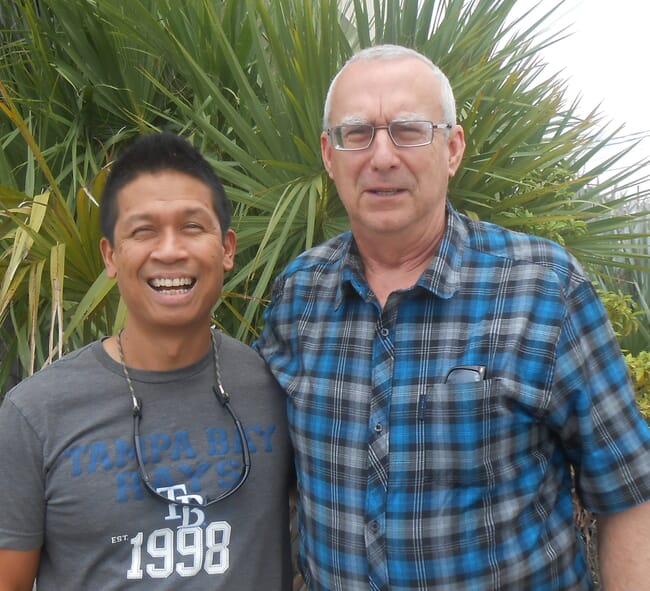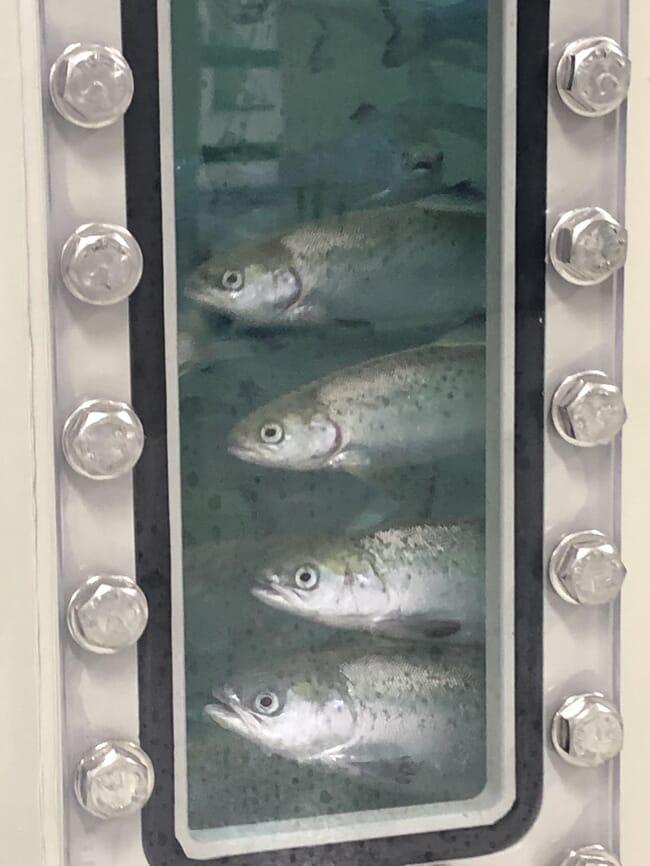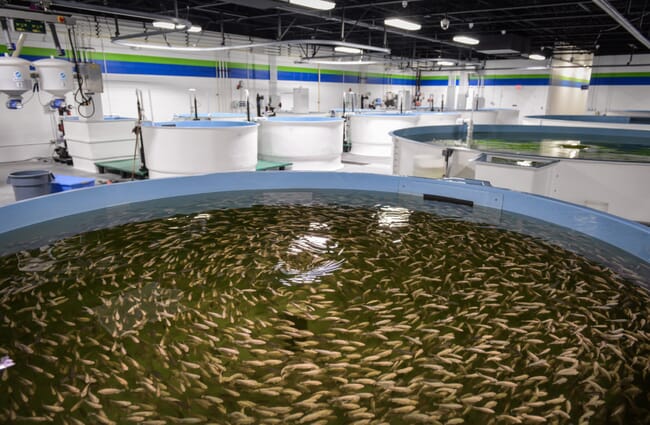
Equipment
In addition to the buildings and tanks, successful RAS farms require bulk feed storage, secure chemical storage, a maintenance shed and workshop, a laboratory, offices and packing/shipping areas. A variety of specialised equipment, some manually operated, others automated, is necessary. How simple or complex the monitoring and control equipment, how much is automated or manual? All must be determined. Is the risk of stock loss reduced or increased by reliance on automated devices?
New technology and products offer what seem to be "plug and play" systems. Automation has its place in RAS, but relying solely on it to keep fish alive and systems running efficiently is extremely dangerous. Computer programmes, remote sensing, in-line water quality testing, alarms and auto-feeders are just some of the automation available today. However, impeccable maintenance, constant calibrations and double-checking with hand-held instruments must still be the rule, not the exception. All aspects of automation must be monitored by skilled operators and management.
Although quality equipment can last years, back-up units and spare parts should be stored on site, and restocked as soon as possible when used. Purchase all equipment based on value, not on cost. Key pieces of equipment essential to RAS relate to:
- Filtration
- Aeration
- Monitoring
- Feeding
- Fish handling
- Temperature control
Huy Tran, a US aquaponics and aquaculture professional, reflects: “Pump quality is vital. Buying cheap swimming pool pumps will cost more in the long run, as these tend to have higher electricity costs and may lead to more fish mortalities.”
His sentiments are echoed by Ben Pohlner, Australia-based aquaculture consultant, who says: “You get what you pay for. Don't always believe the manufacturer's specifications. Oversize the pumps where possible.”
“Check what goes into your feed auger to prevent internal damage,” Tran emphasises.
“Blower outlets should not be restricted by pipe size and unnecessary bends, as this can lead to excess heat and pressure, which will cause a pipe to burst. Use galvanized pipe for 1 metre or more to dissipate heat.”
“Remember that it takes time to change over a blower, even if one is already on site. In a heavily stocked RAS, this may be time you do not have. Back-up blowers need to be already installed and in line ready to go with the flick of a switch,” adds Pohlner.
“Don't underestimate UV lights in disease prevention. Maintain the UV bulbs - an easy one to overlook! Work out what size filter you need and then double it to make certain. Oversized filters are fine. but undersized filters are a disaster,” he continues.
Staffing
Managing an RAS can be a lonely job. Sometimes the operator will be alone with the fish and shoulder all the responsibility for their care. To reduce costs, some RAS companies rely heavily on automation to keep staff levels to a minimum. However, RAS requires a team of managers, technicians, skilled and unskilled workers, like any aquaculture farm. Burn-out of key operators must be avoided.
“Hire an experienced management team with strong experience in RAS. Let the operational managers make the decisions,” advises Dutch aquaculture consultant Jonah van Beijnen.
“Watch for staff cutting corners. Especially on weekends or when no-one else is in the facility. Keep detailed daily records of everything that occurs. This is vital in working out what went right and what went wrong, to prevent future disasters. Ensure staff are trained properly, especially in the filling out and the storage of records,” notes Pohlner.
Operations
Operating an RAS farm is too vast a topic to fully cover here. However, some important non-technical points to a successful operation include workplace safety, sanitation, staff training, public relations, and many more.
Werner Gaus, who is based in China and has been developing RAS systems worldwide for over 30 years, has a number of pointers.
“Compare daily feeding and volume of replacement water (system water consumption) to get a better idea of which RAS is more efficient. The common understanding is that daily water exchange should be 5 percent of the tank water volume. My rule of thumb is 200 litres of water exchange for every kg of 45 percent protein fish feed a day,” he explains.
Gaus lists a number of key factors required to operate an efficient RAS system:
- Produce a constant supply of high quality of water, suitable to the biological and physical needs of the species.
- Release no emissions: ensure smell, noise and pollution don’t exceed the permitted levels.
- Avoid "stress situations".
- Avoid fluctuations, so metabolism can be increased, and species consume more feed with lower FCRs .
- Maintain a high flow/exchange rate through the tanks.
- Maintain high species densities to create constant turbulence inside the tank, to avoid accumulating pathogens and stalked organisms on the floor and wall surfaces.
- Ensure high-velocity flow for the transport of oxygen into and through the tanks.
- Ensure rapid transport of all organic matter to the filtration system without breaking down or dissolving.
- Do not exceed the limit of the biological reactors and the system should run smoothly.
- Regular backwashing of the biological reactors should be performed to remove excess decomposed matter and avoid clogging.
“Data, data, data! Keep good records, make them easy to log, and easy to access. Analyse the data regularly to predict trends and problems,” advises Andrew Hamilton, who runs a multi-species marine fish hatchery in Australia.
“Behavioural change in the fish is generally one of the first signs something has changed. Rely on all your senses, not just what you read. Read the fish, not the books,” he adds.

Species selection
RAS grow-out of low-value freshwater fish is generally uneconomical. While RAS in the US concentrated on producing tilapia for years, this was for the comparatively high-value live fish market. Now the industry is looking to higher-value species. Many new RAS farms are under construction around the world to produce salmon, shrimp and marine fish like pompano, barramundi, snapper and grouper. Venture capital is often available for startups that focus on such high-value species.
“Don't farm slow-growing and/or low-value species and don't farm cold-water species in warm countries,” warns van Beijnen.
“A lot of RAS startups fail when they buy a RAS facility not suited to their species of fish. Better to build a RAS based on the species than to modify an existing one,” says Australia-based aquaculture consultant Edward Capapas.
“Choose your species wisely. Don't go for something new or unproven. The risks are just far too high. There is a good reason why the current species are farmed, and it's usually because they are the most profitable,” Pohlner adds.
Water quality
We all know the importance of water quality in aquaculture. It affects fish growth, survival and health. Every parameter of water quality must be measured, managed and mitigated. The list is long: temperature, ammonia, nitrite, nitrate, pH, hardness, alkalinity, dissolved oxygen, CO2, H2S, salinity, TSS, TDS, ORP and many others. Beneficial and pathogenic bacteria must also be monitored. Without stable water quality within acceptable ranges, fish and production volumes will suffer.
“If the ammonia levels are getting too high, resist the urge to change the water. A rapid decrease in nutrient levels can cause the biofilter to crash,” advises US Professor Kevin Hopkins, who has been teaching aquaculture for 32 years.
“Keep the phytoplankton out. If you are keeping pH around 7 to maximize ammonium vs ammonia, the total NH4-NH3 can be quite high, yet safe. If a plankton bloom occurs, the pH will skyrocket shifting almost everything to NH3. The result is dead fish,” he adds.
“The pH is so important. Un-ionized ammonia (the toxic part) is, for example, is two to three times higher at 7.5 than 7.0, depending on the temperature,” notes US trout and striped bass specialist Lauren Watson.
“People will calculate the exchange rate for round tanks, but there is no such thing. It should be the dilution rate. Incoming treated water is only diluting the metabolites in the tank.”
“Dead zones can lead to pathogenic bacteria buildup. Well-designed troughs and raceways provide laminar flow, a true exchange rate, and a definite area of freshly treated water,” he adds.
“Recently, more attention has been given to CO2 levels [than oxygen ones]. It takes much more aeration to strip out CO2 than to add O2. An acceptable level for CO2 used to be listed as 15 ppm, now most operators use 10 ppm,” says Watson.
Pohlner adds: “Make sure the make-up water meets all required optimal parameters. Once added to the system, it's too late to correct.”
“If you develop problems in the system, STOP FEEDING! This is a simple way to reduce the ammonia load while you sort out the issues.”

© Dennis DeLong
Fish health
Fish grown in RAS can be subject to stress to a degree not found in pond or cage culture. Given the lack of "social distancing" an aggressive health programme is necessary, as any disease will spread rapidly throughout the tanks and the system. Biosecurity, quarantine, sanitation and vaccinations are the first lines of defence. This cannot be overemphasised.
“Quarantine stock before entry or source specific pathogen-free (SPF) stock with known health status. Consider modular systems so that the entire stock is not at risk in disease outbreaks,” recommends Christine Huynh, an Australia-based aquaculture entrepreneur, who previously directed a major RAS farm in the US.
“Make sure you can isolate tanks and systems. If there is a disease problem, discharge directly out of the system to waste,” says Pohlner.
“Preventative medicine includes proper attention to species biology, genetics, water quality, nutrition, system design, biosecurity (quarantine, sanitation, and disinfection) and overall management. Knowledge of how treatment chemicals and antibiotics affect the system is also important. Work with a fish veterinarian or other fish health specialist on these issues and proper diagnosis of diseases. Consult with knowledgeable aquaculture specialists, and experts on recirculating systems, before starting a recirculating aquaculture venture,” adds Roy Yanong, DMV, a US fish veterinarian and university professor.
Conclusion
RAS are here to stay. They work and, more importantly, they must work. Our future seafood protein supply depends on it. Sure there will be failures, companies may come and go. Technology will continue to improve, limiting risks as far as the biology of the animals will allow it. But the one positive in this time of climate change, is that climate in indoor RAS facilities can be controlled no matter what is happening outside. Be wise, be wary, and be successful!
Further information
Click here to access Top tips for setting up a recirculating aquaculture system (RAS): part 1.
Author's note: My special thanks to all the contributors. The world-wide aquaculture community, though diverse, is always willing to lend a hand for the development of a sustainable industry to benefit all. I look forward to hearing of your experiences, and your comments, via andrewleingang36@gmail.com

